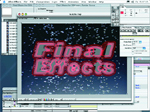
Adobe's Steve Kilisky says with AE V.6 "we have extended our plug-in API to allow third parties to develop motion tracking plug-ins for AE."
|
"Both our systems products and Combustion include integrated technology 'for free,' in the sense that they are included in the list price. Combustion features a full 2D particle system [based on Illusion] and Inferno/Flint/Flame feature technology from RealViz. We do not bundle these as 'free plug-ins' but take a more holistic approach: If a technology is relevant to the majority of our customers it should be integrated into the system. So the technology is as much a part of our software as our own tools are."
Discreet prices range from $60,000 for Smoke SD to about $500,000 for Inferno on SGI Onyx 3200. Prices vary depending on exact configuration; all prices are turnkey systems.
THE AFTER EFFECTS WAY
 |
"With After Effects, one of our philosophies is, 'We eat our own dog food,'" says Steve Kilisky, group product manager for AE at Adobe (www.adobe.com). "After Effects is designed to have a very extensible architecture, to be able to host plug-ins of many types. All of our effects are plug-ins as well, they're written by us as a plug-in but from the user perspective you really don't necessarily know they're a plug-in. We use our own plug-in architecture for a lot of our own features. On occasion we will bundle a third-party plug-in with our software [over last few cycles this has happened once. AE V.5.5 includes Zaxwerks Invigorator Classic, which allows users to create 3D graphics and text inside AE]. This also helps us differentiate AE from the other desktop publishing applications - Composer or Combustion don't offer any 3D typography capabilities. And we just evangelize in general, we're very proactive in the developer community... if someone has that technology, why reinvent the wheel?"

Digital Anarchy's Text Anarchy 2.0 is available for After Effects as well as Discreet products.
|
How essential are plug-ins to After Effects? "There are two perspectives," says Kilisky. "If you talk to users, it's very polarized. There's one camp that thinks plug-ins are for people who can't do it themselves or it's a substitute for creativity. Other people believe time is money and they need to be efficient, so why not use it? Plug-ins are really an opportunity for people to experiment.
"From our perspective on the AE team, plug-ins are critical to the success of our product because it provides users with the widest choice of tools available," continues Kilisky. "It takes our toolset, which we work hard to develop, and gives the users double, triple the amount of things they can add on. It gives them more choices in terms of how they use our tools. It makes them less dependent on Adobe to add features that they may want. Customers are continually given opportunities to add additional components to the product. The plug-ins tie in very closely with our overall goal - that AE is a community of users, plug-in developers and training partners. You're guaranteed that all AE plug-ins will work in AE."
Adobe AE, standard V. 6.0, is $699; the professional edition is $999. "For $5,000 you'd have the BMW or Porsche of AE workstations that would include a budget for a video card, the memory, the right hard disk and $500 to $1,000 for third-party plug-ins," says Kilisky. After Effects runs about 50/50 on Mac G4 dual processor workstations and Windows Pentium 4s or Xeons.

Discreet's Maurice Patel: "Pricing is at the sole discretion of the plug-in vendors."
|
Version 6.0, to be released this month, features over 100 new features. The Professional Edition will include plug-ins from third-party partners, including 3D Assistant's Lite from Digital Anarchy, 3D Invigorator Classic from Zaxwerks and Keylight from the Foundry. "In this release, we have extended our plug-in API to allow third parties to develop motion tracking plug-ins for AE. It includes a new 2D motion tracker, however with the new API, a third party could create a 3D motion tracking plug-in for AE," says Kilisky.
Now let's hear what the plug-in makers have to say about those price disparities.
PLUG-IN: GenArts Sapphire (www. web.genarts.com) suite of 200-plus. V.3.0 for Discreet; V.3.0 recently announced for Shake; V.1.3 recently announced for Avid systems. Also currently working on a new version for Discreet Burn (a background rendering product, to be released in conjunction with Burn).
Platform/System: Discreet; After Effects to be announced third quarter '03.
Cost: Discreet: Inferno $14,000, Flame $10,000, Flint $6,000; After Effects: not priced yet. Avid: DS $4,800, Symphony $3,800, Media Composer $2,800. Plug-ins can be broken out as single sets but the suite is priced more efficiently when purchased whole.
Price Disparity Between Platforms? "It's fairly standard business practice that you need to pay somehow for your development efforts and if you have a high-end market, there are fewer of them and they cost more. For Flames and Infernos... we sell fewer in quantity and we charge a higher price. For the broader markets, Avid Media Composer, Express DV and After Effects in that category, there are many, many more potential customers so you can charge a lot less and make up for it in volume," says Karl Sims, president/ founder of GenArts.
Is it a code issue? "It's hard to predict how much development effort will be to support each platform. The development efforts are reasonably consistent across the different platforms. One thing that's nice is when the same plug-ins run on multiple systems so we don't have to redo it for every Avid product, the same for Discreet.
"A useful analogy may be: If you are selling headlights for Ferraris, they cost more than headlights for Hondas. There are many Hondas out there, so you can price those lower and hope to make up for it in volume," he says.

Media 100's Final Effects allows After Effects users to generate 2D, 3D particle animations.
|
Major Function: "Of the 200-plus plug- ins in this suite, the 3Gs [Glow, Glint, Glare] are very popular. We try to provide a library that's large enough and flexible enough that everybody can continue creating their own new looks. Our Glow happens to have a lot of controls - you can get many different kinds of glows by adjusting the threshold and the width and the color and the falloff. That's why it's one of our most popular, because it's so flexible and quite fast," says Sims.
PLUG-IN: Digital Anarchy Text Anarchy 2.0 (www.digitalanarchy.com)
(Editor's Note: Anarchy Toolbox, a grab bag of eight new filters to be introduced to the Final Cut Pro market, was released in July).
Platform/System: After Effects; V.1.0 is available for Discreet.
Cost: AE: $149, Discreet : $795.
Price Disparity Between Platforms? "It's basic economics. There's a lot less Discreet users than AE users, so to make any return on the investment, obviously if you only have 2,000 to 3,000 active users in the market you're going to have to price it higher to make that money back. Discreet users, by and large, pay a lot more for the hardware they run the software on so you would expect that they would be able to afford a little bit higher price," says Jim Tierney, president/founder of Digital Anarchy.
"Plug-ins are just features. They come in two varieties: ones that add features and ones that save time," he adds. "Adobe and Discreet let others do that and spend more time developing features that benefit their user bases."
Major Function: "The previous filter set was designed for creating background text elements. Text Anarchy 2.0 is intended for projects where text is the main component of the design, which makes the creation of complex text animation significantly easier," says Tierney. "You look for things the host app doesn't do and generally a lot of users like to do. We look for what's being done in broadcast design and what's coming and how can we make that easier. On Discreet, the 1.0 version is a particle system that deals with text, it makes it very easy to use text as an element. It takes care of the creation and animation of text, you can enter how you want it to look, what you want it to say and it takes care of animating and creating it. Usually you'd have to have 30 layers and set keyframes for all of them. We make it easier."
PLUG-IN: Boris FX Red (www.boris fx.com)
Platform/System: After Effects and Discreet.
Cost: $1,595
Price Disparity Between Platforms?
"We buy and maintain the hardware to develop plug-ins for around two dozen NLEs and compositing applications. In many cases, we're able to leverage the largest part of the work we do for one of these hosts across virtually all of them but, in other cases, specific plug-ins are for all practical purposes their own development efforts. Another consideration is among how many users we're able to amortize our costs," says Tim Wilson, product manager for Boris Red.
"A platform that costs us more to maintain, that offers unique challenges for development - with fewer users to sell to - will necessitate a product with higher costs," he continues. "That said, our efforts to support so many systems means that we can release products for all of them at lower prices than our competitors. Our emphasis has always been on value, rather than price alone, although we're happy to be able to do so well on both counts."
Major Function: Boris Red plugs into over 20 NLEs on both Mac and Windows, and offers motion tracking, vector paint,
rotoscoping, advanced 2D and 3D titling, high-end image processing, including Optical Flow, animation and extrusion of Adobe Illustrator files and advanced 2D and 3D compositing.
PLUG-IN: Zaxwerks ProAnimator (www.zaxwerks.com)
Platform/System: Discreet and After Effects, including on Mac (OS 9 and OS X) and Windows (XP and 2000).
Cost: $895 per seat
Price Disparity Between Platforms? None.
Major Function: Designed for video editors who need 3D title and logo animations but don't have time to learn a 3D program, ProAnimator works like an editing program instead of a keyframe-based compositing program. To be used in the edit suite with clients watching and directing; typical for new users to create broadcast-worthy 3D title/logo animation in 15 minutes, start to finish, according to president Zax Dow.
PLUG-IN: Knoll Light Factory 2 distributed by Red Giant Software (www.redgiantsoftware. com); Knoll Spark Pack distributed by Digital Anarchy.
Platform/System: KLF2 for After Effects; KSP for Discreet.
Cost: KLF2, AE: $395/CD, $345/download; Discreet Spark Pack: $1,295
Major Function: Lens flares and lighting effects. Recently updated with four new flares and 16-bit rendering support in AE.